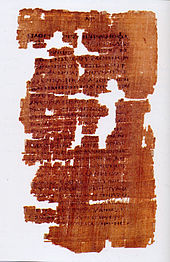Acts of Peter and the Twelve
This article needs additional citations for verification. (July 2018) |
 |
The Acts of Peter and the Twelve is one of the texts from the New Testament apocrypha which was found in the Nag Hammadi library.
The text contains two parts, an initial allegory, and a subsequent gnostic exposition of its meaning. The allegory is thought to have been originally a work in its own right. The text is dated to the 2nd or 3rd century and is attested Greek and Coptic. The author claims to be Peter the Apostle, and thus is pseudepigraphical.[1]
The allegory describes the tale, similar to the Parable of the Pearl in the Gospel of Matthew, of a pearl merchant who is selling a pearl at a great price. The merchant is shunned by the rich but the poor attend him in droves, and learn that the pearl is kept at the home city of the merchant, "Nine Gates", rather than being carried on him. As such those who desire it must trek the arduous journey to Nine Gates.
The name of the merchant is Lithargoel, which the text translates as being "lightweight, glistening stone", i.e. the merchant himself is the "pearl". Ultimately the merchant reveals himself to be Jesus.
References[]
- ^ István Czachesz (2002). "7. Acts of Peter and the Twelve" (PDF). Apostolic commission narratives in the canonical and apocryphal Acts of the Apostles. University of Groningen. Retrieved 19 July 2018.
External links[]
- Acts of Peter and the Twelve Text from The Gnostic Society Library
- 2nd-century Christian texts
- 3rd-century Christian texts
- Apocryphal Acts
- Petrine-related books
- Pseudepigraphy
- Nag Hammadi library
- New Testament apocrypha stubs
